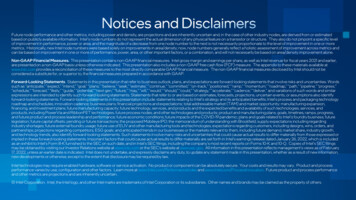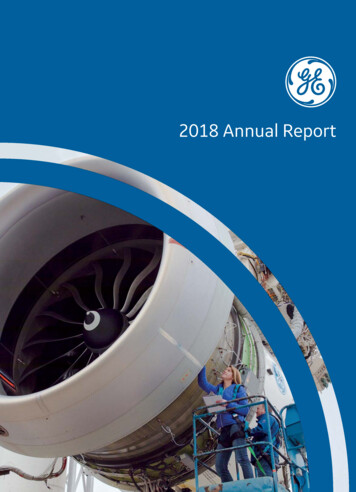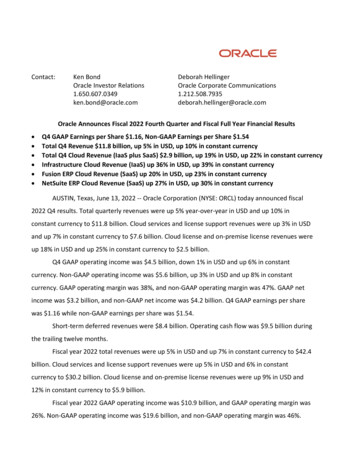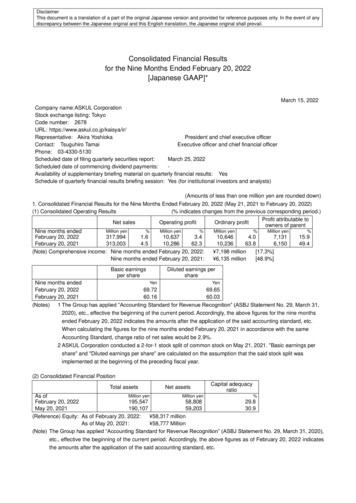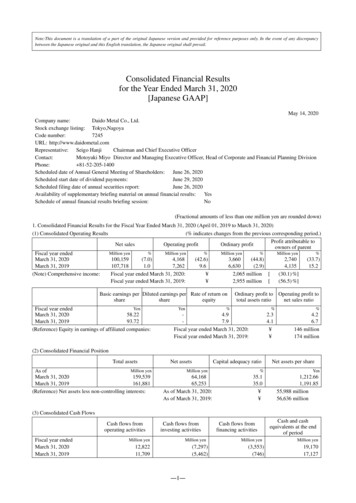
Transcription
KUROKIJapanese GAAP is equivalent to IFRS.
PRESENCEJapan has one of the world's largest equity marketsMarket value (as of the end of 2003)NYSE14.2TOKYONASDAQLONDON3.73.63.0( trillion)Source:World Federation of ExchangesJapanese issuers play an important rolein Euro marketsValue of bonds issued outside Japan by Japanese resident borrowers(including 81999200020012002(2003Source:Ministry of Finance Japan128.88 1 as of 31 March 2004)Most of these bonds are issued in the Euro markets.
Many Japanese issuers are listed onEuropean exchanges.Number of listed Japanese issuers (as of 19 gJanuary s417Frankfurtam ZagrebVeneziaBordeauxstockConvergence is an important goal.bond KUROKI
Accounting,Auditing and Disclosure Systems in JapanointPniMasAccounting, auditing and disclosure systems in Japan are essentiallyequivalent to and consistent with internationally recognized systems.Convergence is an important goal for all market participants to fosterconfidence and efficiency in global capital markets. In this context, continuedefforts towards this goal will be made.Japanese securities issuers have played an active part in the EUmarkets. There are approximately 75 Japanese issuers with shares listed and atleast 180 issuers with bonds listed within the EU.Financial statements prepared in accordance with Japanese GAAP andaudited in accordance with Japanese GAAS have been widely accepted by investorsin the EU markets as well as foreign investors in Japanese markets.Given these facts, both the EU markets and Japanese securities issuerswill benefit from the continued use of financial statements prepared in accordancewith Japanese GAAP and audited in accordance with Japanese GAAS.viOverewThrough the so-called "Financial Big-Bang" since 1996, accounting, auditing and disclosuresystems in Japan have been substantially revised and have essentially become equivalent to and consistentwith internationally recognized systems.The revisions include, for example,- Revision of Consolidated Financial Statements, Retirement Benefits, Accounting for Income Taxes, FairValue Accounting for Financial Instruments, Impairment of Assets, and Business Combinations.- The establishment of the new Auditing Standards including "going concern" and "risk approach."- The measures to enhance disclosure including risk information, governance-related information andMD&A.
untioccAngAs the result of above reform, Japanese GAAP is one of the "high quality, internationallyrecognized accounting standards" mentioned in the G8 Declaration on "Fostering Growth and Promoting aResponsible Market Economy" in June 2003. Now there are few differences between Japanese GAAP and IFRS,except for some relatively minor ones. Financial statements prepared by listed companies in accordance withJapanese GAAP have high comparability for investors with those in accordance with IFRS or US GAAP.have strong incentive for the convergence of accounting standards. Convergence process would progress moreefficiently by making use of such incentive inherent in market participants.Convergence of accounting standards should progress through selection and judgment bymarket participants. The accounting standards currently used in global financial markets, such as JapaneseGAAP, can play an important role in the convergence process.Convergence of accounting standards is an important goal, which is common to all marketparticipants in order to foster confidence and efficiency in global capital markets. This goal is shared by the IASBand each national standards setter aiming to achieve convergence of accounting standards.In the context of that goal, great importance should be attached to the process towardsconvergence of accounting standards. Considering the fact that Japanese securities issuers participate in globalbusiness and fund-raising activities using financial statements prepared in accordance with Japanese GAAP, theyThe Accounting Standards Board of Japan ("ASBJ") established in July 2001, has committedcontinuously to improve Japanese GAAP in line with developments in other major internationally recognizedaccounting standards including IFRS and US GAAP. As part of this effort, the ASBJ will continue to worktogether with the IASB to develop high quality accounting standards. Through such process, current differencesbetween Japanese GAAP and IFRS will be reduced.International Comparison of Accounting Standards-Overview of Major Japanese GAAP, IAS/IFRS, and US GAAPAccounting StandardsFinancial InstrumentsBusiness CombinationsImpairment of AssetsRetirement BenefitsIncome TaxesResearch & DevelopmentItemsJapanese GAAPIAS/IFRSUS GAAPMeasurement of securitiesFair value or amortised cost (bonds) depending on categoryFair value or amortised cost (bonds) depending on categoryFair value or amortised cost (bonds) depending on categoryEstimating potential credit losses/impairmentDiscounted future cash flowsDiscounted future cash flowsDiscounted future cash flowsDerecognition of financial assetsLegal isolation required (Financial-components approach)Legal isolation not required (Primarily risks and rewards approach)Legal isolation required (Financial-components approach)Measurement of derivativesFair valueFair valueFair valueHedge accountingWhen hedging criteria are metWhen hedging criteria are metWhen hedging criteria are metBasic methodPurchase methodPurchase methodPurchase methodPooling of interests methodExceptionally used only when strict criteria are metPurchase method onlyPurchase method onlyGoodwillStrictly amortised with impairmentNot amortised, impairment onlyNot amortised, impairment onlyGroupingLowest level (smallest identifiable group of assets) for which cash flowsare largely independent of cash flows of other assetsLowest level (smallest identifiable group of assets) for which cash flowsare largely independent of cash flows of other assetsLowest level (smallest identifiable group of assets) for which cash flowsare largely independent of cash flows of other assetsIndication of impairmentAssessedAssessedAssessedRecognition testUndiscounted future cash flowsRecoverable amount (Higher of net selling price and value in use)Undiscounted future cash flowsMeasurementRecoverable amount (Higher of net selling price and value in use)Recoverable amount (Higher of net selling price and value in use)Fair valueReversal of impairment lossProhibitedReversed (excluding goodwill)ProhibitedRecognition of liabilityRetirement benefit obligation adjusted for unrecognised actuarialgains/losses and past service cost, minus plan assetsRetirement benefit obligation adjusted for unrecognised actuarialgains/losses and past service cost, minus plan assetsRetirement benefit obligation adjusted for unrecognised actuarialgains/losses and past service cost, minus plan assetsActuarial gains/lossesStrictly amortised without corridorCorridor amortisationCorridor amortisationRecognition of additional minimum liabilityNot recognisedNot recognisedUnfunded Accumulated Benefit ObligationBasic methodAsset liability methodAsset liability methodAsset liability methodRecording of deferred tax assetsBased on recoverability/realizabilityBased on recoverability/realizabilityBased on recoverability/realizabilityDevelopment costsExpensed when incurredCapitalisedExpensed when incurredConsolidatedFinancial StatementsScope of subsidiariesBased on controlBased on controlBased on majority voting interestPresentation of minority interestsBetween liability and equityEquityBetween liability and equity (Under deliberation to change to equity)Investment PropertyMeasurementCostFair value or costGenerally cost*Consistent treatment :
inAuditgJapanese auditing systems have also been revised to become equivalent to the internationallevel. To begin with, the Auditing Standards and the Implementation Guidance in Japan (Japanese GAAS)have become equivalent in substance to and consistent with the International Standards on Auditing("ISAs") as a result of the establishment of the new Auditing Standards in January 2002, in which emphasison discovering fraud and the treatments of "going concern" were clearly covered and "risk approach"thoroughly introduced and implemented. Accordingly, if foreign securities issuers are audited inaccordance with ISAs, such audit is accepted in Japan.In addition, in view of the international initiatives to strengthen the auditing regime in linewith the U.S. Sarbanes-Oxley Act of 2002, the Certified Public Accountants Law ("CPA Law") was revised inMay 2003 and will be effective in April 2004. This revision incorporates prohibition of providing certainnon-audit services contemporaneously with audit services and requirement of audit partner rotation inorder to enhance auditor independence. The CPA Law also incorporates establishing "the CPA andAuditing Oversight Board" ("CPAAOB") in order to enhance auditor oversight.Through these revisions of auditing standards, new independence rules and auditorregulations, financial statements of listed companies which are audited by Japanese audit firms inaccordance with Japanese GAAS have the same level of assurance as those audited in accordance with ISAs.and vernanceerusoDisclrate GoCorpoDisclosure system in Japan is in line with the International Disclosure Standards (IDS) setby IOSCO in 1998. In March 2003, the disclosure system was further strengthened so as to includeenhanced disclosure of risk information and governance-related information such as internal control systemas well as improved MD&A (Management's Discussion and Analysis) disclosure.Corporate governance system in Japan conforms to the "OECD Corporate GovernancePrinciples." The corporate governance regimes have recently been strengthened, in particular, by enhancedmeasures including the introduction of an option of audit committee system in the Commercial Code andthe Securities and Exchange Law and self-regulations established by the Japan Business Federation.nomocEotutionbirtnoCyThere are approximately 75 Japanese issuers with shares listed and at least 180 issuers withbonds listed within the EU. Japanese securities issuers will continue to play an active part in the EU capitalmarkets through the global business fund-raising activities and, as a result, will contribute to developmentsof the EU economy as well as the world economy.
If you have any questions, please contact us listed below.Financial Services Agency(http://www.fsa.go.jp/refer/jgaap)TEL: 81-3-3506-6263Mail: info-jgaap@fsa.go.jpAccounting Standards Board of Japan(http://www.asb.or.jp/index e.html)TEL: 81-3-5561-8449The Japanese Institute of Certified Public Accountants(http://www.jicpa.or.jp/n eng)TEL: 81-3-3515-1130MEMO:The information in this document is as of 15 March 2004 unless otherwise stated.
International Comparison of Accounting Standards - Overview of Major Japanese GAAP, IAS/IFRS, and US GAAP Supplemental Information AccountingStandardsItemsSupplemental Information[Consistent Treatment](JPN)(IAS)(US) Classification of securities and measurement:1. Trading securities・・・Measured at fair value with gains/losses included in net profit or loss2. Held-to-maturity securities・・・Measured at amortised costMeasurement of3. Available-for-sale securities・・・Measured at fair value with gains/losses recognised in equitysecurities[Other](IAS) An entity is permitted to designate any financial asset or financial liability on initial recognition as one to be measured at fair value, withchanges in fair value recognised in profit or loss. (Fair value option)FinancialInstruments[Consistent Treatment](JPN)(IAS)(US) Estimated cash flows discounted at loan's original effective interest rate are used in measurement of impairment.[Other](JPN) Receivables are classified into three categories for estimating potential credit losses. For "Normal receivables,"reasonable criteria suchas historical ratio of credit losses are used; For "Doubtful receivables," either recoverable amount from collateral/guarantee or estimated cashEstimatingpotential credit flows are used; For "Bankruptcy receivables," recoverable amount from collateral/guarantee is used.losses/impairment (IAS) Financial asset is first assessed whether objective evidence of impairment exists individually. Asset that has been individually assessedfor impairment and found not to be individually impaired is included in collective assessment of impairment.(US) For individually impaired loans, impairment is measured based on expected future cash flows, except as practical expedient impairmentmay be based on loan's market price or fair value of collateral. For loans that are not impaired individually, probable loss in a group of loans isaccrued.[Consistent Treatment](JPN)(US) "Financial-components approach" in which financial component that comprises financial asset is derecognised when control isDerecognition of transferred to another party, and the retained financial component is continued to be recognised.financial assets [Other](IAS) "Risks and rewards approach" in which financial asset is derecognised when substantially all risks and rewards are transferred toanother party, precedes evaluation of transfer of control. No legal isolation requirement in IAS.Measurement of [Consistent Treatment]derivatives(JPN)(IAS)(US) Derivatives are measured at fair value.[Consistent Treatment](JPN)(IAS)(US) As part of hedge accounting requirement, documentation of risk management policy etc. and assessment of hedge effectivenessare required.[Other](IAS)(US) "Fair value hedge" which hedges risk in change in fair value and "Cash flow hedge" which hedges risk in change in future cash flowsHedge accountingare accounted for differently.(JPN) In principle, both risks in change in fair value and change in cash flows are accounted for by deferring gains/losses on hedginginstrument. However, as hedge accounting requirement is consistent with IAS and US GAAP, difference in net profit or loss is considered to beminor. In certain cases, gains/losses on both hedged item and hedging instrument may be recognised in net profit or loss in the sameaccounting period.Basic method[Consistent Treatment](JPN)(IAS)(US) "Purchase method" is the basic method in all three. IAS(IFRS3) and US GAAP prohibit "Pooling of interests method" and"Purchase method" is applied to all business combinations. Under Japanese GAAP, "Pooling of interests method" is applied only toexceptionally limited circumstances when strict criteria are met.[Other](JPN) "Uniting of interests" is distinguished from "Acquisition" which differs in economic substance. However, "Pooling of interests method" isapplied only to exceptionally limited circumstances when all of the following strict criteria and other requirements are met.Pooling of1. Consideration for combination is stock with voting rights.Businessinterests method2. Ratio of voting rights after business combination is within 50:50 plus or minus approximately 5 percentage points.Combinations3. There are no certain facts that indicate existence of control. (Ex. Number of board members.)According to our survey on the actual cases over 10-year period, approximately only 7% of the cases would have met the above criteria.Goodwill[Consistent Treatment](IAS)(US) Goodwill is not amortised but tested for impairment.[Other](JPN) Goodwill is strictly amortised within 20 years using a systematic method, with impairment test in addition.
AccountingStandardsItemsGroupingIndication ofimpairmentImpairmentofAssetsSupplemental Information[Consistent Treatment](JPN)(IAS)(US) In recognition and measurement of impairment, lowest level (smallest identifiable group of assets) for which cash flows arelargely independent of cash flows of other assets is used for grouping.[Consistent Treatment](JPN)(IAS)(US) Requirement to assess indications of impairment for performing the recoverability (recognition) test (under Japanese and USGAAP) or estimating the recoverable amount (under IAS) is consistent in all three standards. Examples of indications of impairment such aschange in extent and manner of use of asset, decrease in market price of assets are similar.[Consistent Treatment](JPN)(US) Impairment loss is to be recognised (assessed as not recoverable) when carrying amount of asset exceeds sum of undiscounted cashflows.Recognition test[Other](IAS) If indication of impairment exists, recoverable amount, which is the higher of asset's net selling price and value in use, is estimated. Ifrecoverable amount is less than carrying amount, the difference is recognised as impairment loss.Measurement[Consistent Treatment](JPN)(IAS) Impairment loss is carrying amount in excess of recoverable amount, which is the higher of asset's net selling price and value in use.However under Japanese GAAP, impairment loss is recognised only on asset assessed as not recoverable under recognition test. No suchrecognition test is performed under IAS, but recoverable amount is estimated if indication of impairment exists, and impairment loss ismeasured as carrying amount in excess of recoverable amount.[Other](US) For asset assessed as not recoverable, impairment loss is measured as carrying amount in excess of fair value.[Consistent Treatment](JPN)(US) Impairment loss is not reversed.Reversal of[Other]impairment loss(IAS) Impairment loss is reversed if there has been a change in estimates used to determine recoverable amount. (Impairment loss for goodwillis not reversed except in specific circumstances.)Recognition [Consistent Treatment](JPN)(IAS)(US) Liability is recognised as the amount of retirement benefit obligation adjusted for unrecognised actuarial gains/losses andunrecognised past service costs, minus plan assets.[Consistent Treatment](IAS)(US) Unrecognised actuarial gains/losses that are equal to the greater of 10% of the present value of benefit obligation (PBO) and 10% ofthe fair value (market related value) of plan assets, do not need to be amortised (corridor amortisation).[Other](JPN) All unrecognised actuarial gains/losses are strictly subject to amortisation.Recognition of [Other](US) Liability that is at least equal to unfunded accumulated benefit obligation is recognised as additional minimum liability. There is no suchadditionalminimum liability requirement under Japanese GAAP or IAS.Income TaxesBasic method[Consistent Treatment](JPN)(IAS)(US) Asset liability method is used in all three standards, and basic accounting is consistent.Recording ofdeferred taxassets[Consistent Treatment](JPN)(IAS)(US) Recoverability/realizability is assessed for recording of deferred tax assets.[Other]Although stated differently, standards do not differ in substance.(JPN) Criteria such as sufficiency of taxable income based on earnings capacity are used in assessing the recoverability of deferred tax asset.(IAS) Deferred tax asset is recognised to the extent that it is probable that taxable profit will be available against which deductible temporarydifference can be utilised.(US) Deferred tax asset is reduced by valuation allowance if it is more likely than not that some portion or all of deferred tax asset will not berealized.[Consistent Treatment](JPN)(US) Both research and development costs are expensed when incurred.Research &Development costs[Other]Development(IAS) Research cost is expensed when incurred, but development cost is capitalised.Scope tmentProperty[Consistent Treatment](JPN)(IAS) Based on control. An enterprise is included in the scope of consolidation if control exists, even in cases in which majority votinginterest is not owned.[Other](US) Based on ownership of majority voting interest.[Consistent Treatment](JPN)(US) Presented between liability and equity (after liability) under Japanese GAAP. Under US GAAP, generally between liability andPresentation ofequity, but currently under deliberation to change to presentation as equity.minority interests[Other](IAS) Presented in equity.Measurement[Consistent Treatment](JPN)(US) At cost under Japanese GAAP, and generally at cost under US GAAP.[Other](IAS) Option to choose fair value model or cost model.
Japanese GAAP have high comparability for investors with those in accordance with IFRS or US GAAP. Convergence of accounting standards is an important goal, which is common to all market participants in order to foster confidence and efficiency in global capital markets. This goal is shared by the IASB
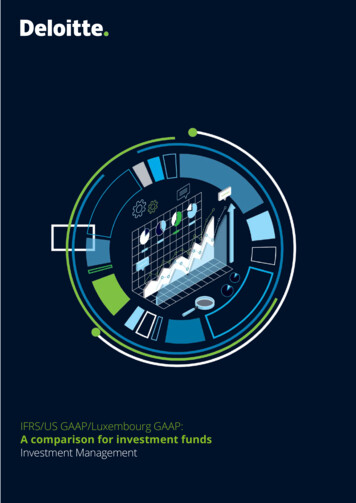
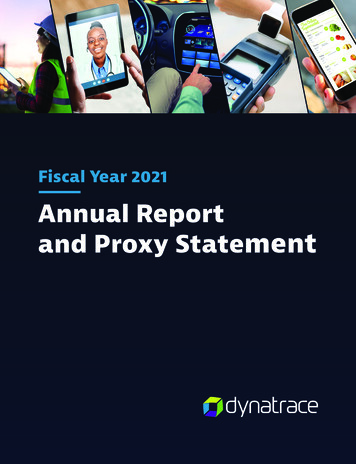
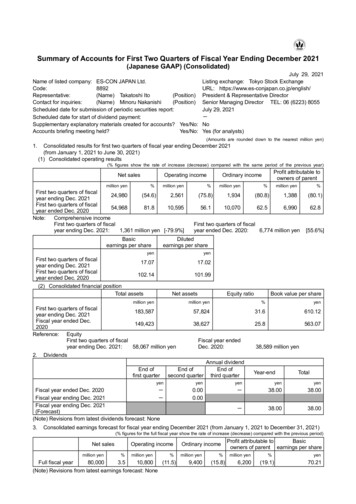
![CONSOLIDATED EARNINGS REPORT FOR FISCAL 2020 [Japanese GAAP]](/img/28/12517813990599999999-dec450c5-8652-4f54-8376-7abc1527dd0b.jpg)
